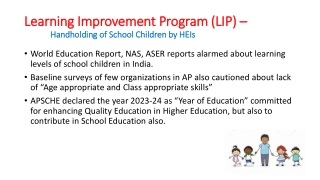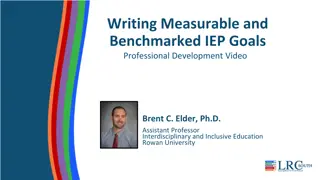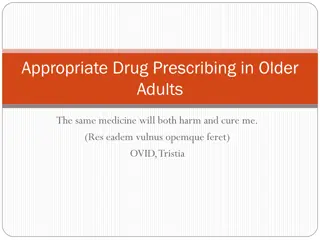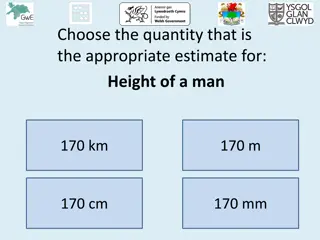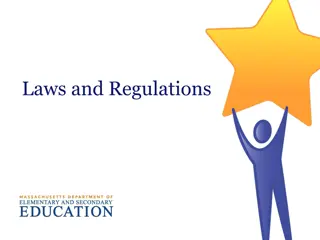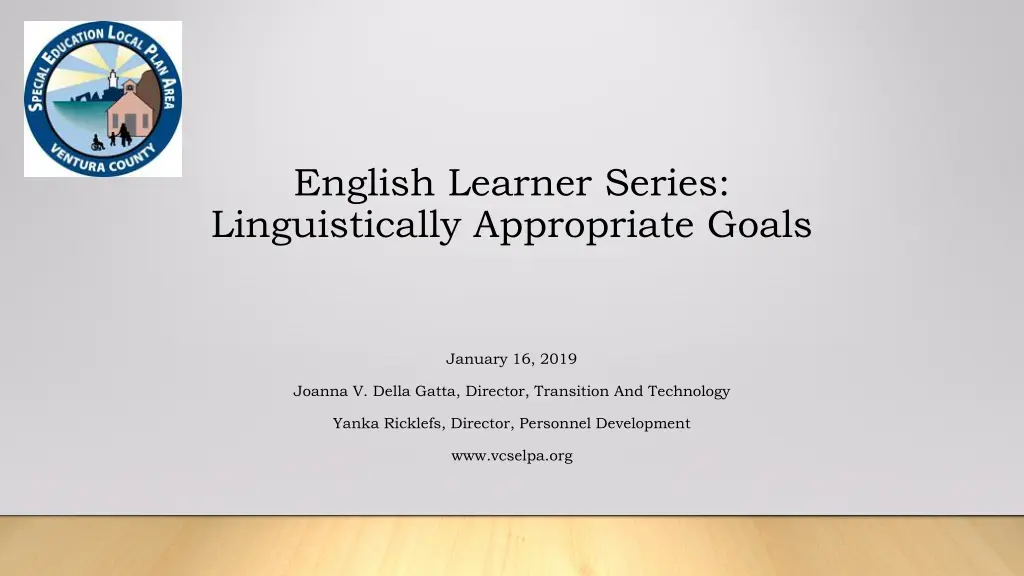
Linguistically Appropriate Goals for English Learners
Learn about the importance of setting linguistically appropriate goals for English learners under legal obligations such as the Individuals with Disabilities Education Act (IDEA) and California education regulations. Discover the necessity of considering language needs in Individualized Education Programs (IEPs) and implementing programs for English language proficiency development.
Download Presentation

Please find below an Image/Link to download the presentation.
The content on the website is provided AS IS for your information and personal use only. It may not be sold, licensed, or shared on other websites without obtaining consent from the author. If you encounter any issues during the download, it is possible that the publisher has removed the file from their server.
You are allowed to download the files provided on this website for personal or commercial use, subject to the condition that they are used lawfully. All files are the property of their respective owners.
The content on the website is provided AS IS for your information and personal use only. It may not be sold, licensed, or shared on other websites without obtaining consent from the author.
E N D
Presentation Transcript
English Learner Series: Linguistically Appropriate Goals January 16, 2019 Joanna V. Della Gatta, Director, Transition And Technology Yanka Ricklefs, Director, Personnel Development www.vcselpa.org
A Moral & Legal Obligation Individuals with Disabilities Education Act 2004 (IDEA) Why is it important to talk about English Learners? Preventing Disproportionality In 2017-2018, English learners constituted 20% of all students in CA schools and English learners with disabilities 30% of students with disabilities. In 2017-2018, English learners constituted 22% of all students in Ventura county and constituted 26% of all students with disabilities in Ventura County (12/1/17 CASEMIS). Most at-risk learner subgroup
Education Code EC 56345 (b) (2) For individuals whose native language is other than English, linguistically appropriate goals, objectives, programs, and services.
California Code of Regulations The IEP team must consider the language needs of the student as those needs relate to the student s IEP. Specifically, the IEP must include linguistically appropriate goals, objectives, programs and services .
California Code of Regulations Title 5, Section 3001 (m) (1)(A) those activities which lead to the development of English language proficiency; and (1)(B)Those instructional systems which lead to the language development needs of English language learners. (m)(2) For individuals whose primary language is other than English, and whose potential for learning a second language, as determined by the IEP team, is severely limited, the IEP team may determine that instruction may be provided through an alternate program, including a program provided in the individual s primary language. The IEP team must periodically, but not less than annually, reconsider the individual s ability to receive instruction in the English language Linguistically appropriate goals, objectives, and programs means:
Even though it is not a legal requirement to formally identify a preschool age student as an English Learner in California, federal regulations state IEP team must follow bilingual assessment protocol to determine the language of preference of the student if the parent indicates that a language other than English is spoken at home and assess according to second language learner requirements (EC 56440 and 56441.11). Legal requirements for preschoolers For purposes of IDEA s requirement to write IEPs that meet the language needs of the student, IEP teams must ensure that their IEPs are linguistically appropriate. This is not a formal EL identification that is entered in the LEA/district student database.
As a comprehensive approach to ELD, the English Language Arts/English Language Development (ELA/ELD) Framework for California Public Schools states: What Does this Mean?? English learners at all English proficiency levels and at all ages require both integrated ELD and specialized attention to their particular language learning needs, or designated ELD. (p. 119)
OBLIGATION #1 Designated ELD Protected time during the regular school day where qualified teachers work with English learners grouped by similar proficiency levels DUAL OBLIGATION for Services Main Focus: Student production of language (Speaking and Writing) using the CA ELD Standards
OBLIGATION #2 Integrated ELD Provide meaningful access to ALL grade-level CCSS academic content through research-based strategies and techniques (SDAIE) used in tandem with ELD Standards DUAL OBLIGATION for Services Main Focus: Accessing & mastering content standards across all disciplines while using ELD standards to amplifying/highlight the key language knowledge and skills needed for ELs to succeed
A Comprehensive Program for English Learners Designated ELD Instruction Integrated ELD Instruction
ELD Standards Language acquisition is treated as a non-linear linguistic and social process Asset vs. deficit approach literacy foundational skills target varying profiles of ELs, tapping linguistic resources Focus on teaching academic English
Three Critical Principles for Developing Language and Cognition in Academic Contexts ELD Standards 1. Interacting in meaningful ways 2. Learning about how English works 3. Using foundational literacy skills
What about students who took an alternate to the ELPAC- the VCCALPS? Use the VCCALPS performance levels to assist with determining relative areas of need. Scoring on the VCCALPS has been aligned to the ELPAC.
Foundations in English Language Development: Listening Preschool Goals Speaking Reading Writing
Correlations Mode of Communication Common Core Domain ELPAC Performance Level EL Proficiency Level Listening + Speaking Collaborative Minimally Developed Emerging Reading + Listening Interpretive Somewhat/Moderately Developed Expanding Speaking + Writing Productive Well Developed Bridging
Resource for the IEP Team Using the ELPAC levels to help write linguistically appropriate goals
Work in groups of 2-3 Refer to graphic organizer ELD/ELA Correlations Activity Using SIRAS GoalWizard or your IEP Goals resources
How might an EL expert assist with developing linguistically appropriate goals?
Scores/levels for ELPAC/VCCALPS Present Levels of Performance Summary of progress in language proficiency in Reading and Writing areas and Listening and speaking in the Communication area Note: For preschoolers, English Proficiency level determined from the Preschool English Learner Survey (PELS) is noted on the Preschool Strategies page.
Present Levels of Performance Academics Reading/Writing: Made progress (moved from beginning to moderately developed on the ELPAC), expanding in English Language Proficiency. Communication: Uses both English and Spanish in the classroom and playground Struggles with understanding academic English Uses Mixteco with peers Communicates with parents in Hmong but uses English conversationally at school Proficient in basic interpersonal communication skills (conversational) skills Beginning to develop cognitive academic language proficiency
Three things to consider when addressing language needs Language proficiency Level of functioning Student s disability J. Butterfield, 2016
IEP Goals State present levels: strengths and weaknesses Include assessment results (English and Native Language performance and proficiency) Determine areas of need
Linguistically Appropriate Goals Aligned to California ELD standards in listening, speaking reading or writing Aligned to students current language proficiency level Drafted to account for student s language ability J. Butterfield, 2016
Goals Goal(s) drafted address need(s) in the area(s) of English Language Proficiency (Reading, Writing, Listening, Speaking) Goal Correlate Correlate to assessment results (ELPAC/ VCCALPS/PELS) and present levels Goal Goal(s) in the area of language most likely will be in literacy or communication Select Select from the ELD standards in the GoalWizard Use the ELA correlation to guide the choice of goals that involve language and which will lead to linguistically appropriate goals Use
6 grader Reading: Somewhat Developed Constructing a Goal Listening: Moderately Developed Speaking: Moderately Developed Writing: Somewhat Developed
How might an EL expert assist with developing linguistically appropriate goals?
Selecting Goals for English Learners 1. Domain- ELD Communication Mode or Language Knowledge 2. Category- Collaborative, Interpretive, Productive, Connecting & Condensing Ideas, Expanding & Enriching Ideas, Structuring Cohesive Texts 3. Grade level 4. ELD Proficiency- Emerging, Expanding, Bridging 5. ELA Correlations
Goals for English Language Development Area of Need- Reading, Writing, Communication For goals that involve language Responsible discipline- tied to location of service on ELD page Reason for goal- tied to need from ELPAC/VCCALPS/PELS scores and present levels Language of instruction All language goals must be linguistically appropriate
Practice: Draft a Goal Choose a student who is an English Learner Review current Present levels page and test scores What kind of a goal should you develop?
Resources Ventura County SELPA: www.vcselpa.org ELD Standards: https://www.cde.ca.gov/sp/el/er/eldstandards.asp

